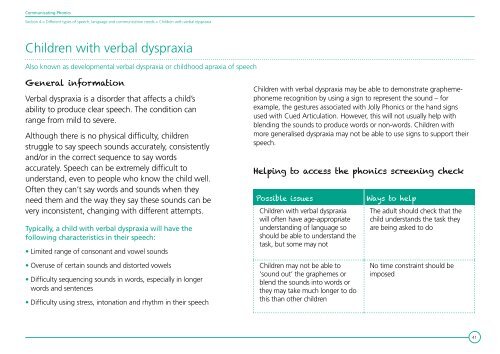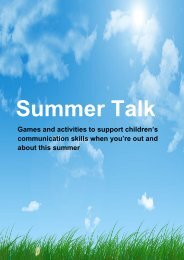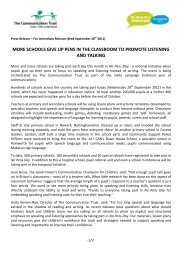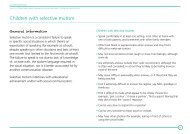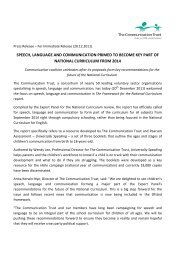Communicating Phonics - The Communication Trust
Communicating Phonics - The Communication Trust
Communicating Phonics - The Communication Trust
You also want an ePaper? Increase the reach of your titles
YUMPU automatically turns print PDFs into web optimized ePapers that Google loves.
<strong>Communicating</strong> <strong>Phonics</strong>Section 4 > Different types of speech, language and communication needs > Children with verbal dyspraxiaChildren with verbal dyspraxiaAlso known as developmental verbal dyspraxia or childhood apraxia of speechGeneral informationVerbal dyspraxia is a disorder that affects a child’sability to produce clear speech. <strong>The</strong> condition canrange from mild to severe.Although there is no physical difficulty, childrenstruggle to say speech sounds accurately, consistentlyand/or in the correct sequence to say wordsaccurately. Speech can be extremely difficult tounderstand, even to people who know the child well.Often they can’t say words and sounds when theyneed them and the way they say these sounds can bevery inconsistent, changing with different attempts.Typically, a child with verbal dyspraxia will have thefollowing characteristics in their speech:• Limited range of consonant and vowel soundsChildren with verbal dyspraxia may be able to demonstrate graphemephonemerecognition by using a sign to represent the sound – forexample, the gestures associated with Jolly <strong>Phonics</strong> or the hand signsused with Cued Articulation. However, this will not usually help withblending the sounds to produce words or non-words. Children withmore generalised dyspraxia may not be able to use signs to support theirspeech.Helping to access the phonics screening checkPossible issuesChildren with verbal dyspraxiawill often have age-appropriateunderstanding of language soshould be able to understand thetask, but some may notWays to help<strong>The</strong> adult should check that thechild understands the task theyare being asked to do• Overuse of certain sounds and distorted vowels• Difficulty sequencing sounds in words, especially in longerwords and sentences• Difficulty using stress, intonation and rhythm in their speechChildren may not be able to‘sound out’ the graphemes orblend the sounds into words orthey may take much longer to dothis than other childrenNo time constraint should beimposed41


